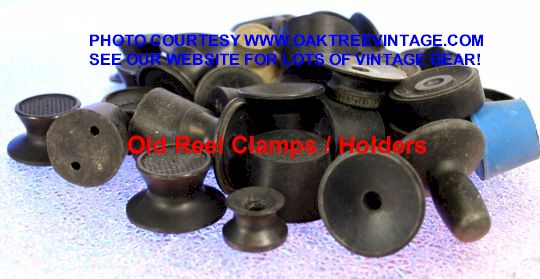Notes / tips about purchasing / buying pre-recorded reel
to reel tape
(much of the following can also be applied to 8-Track tapes, Video tapes
and some cassettes):
There are many potential pitfalls to purchasing ‘old’ / ‘NOS’ / used /
‘still sealed’ / ‘NIB’ etc. pre-recorded tape that you actually hope to
listen to and enjoy. I have a LOT of tape pass thru my hands. I have
learned to exercise considerable trepidation
when allowing myself to get too excited about
playing a tape for the first time. I know the chance of at least one of
the following issues may occur. Some can be rectified. A few can be
accepted. Many render the tape un-playable, un-enjoyable, un-usable and
can be deleterious to the tape deck / machine.
While you can generally 'look' at a record album, and
have a pretty good, if not concrete idea of it's true quality,
unfortunately, for many of the following 'tape
ailments', there’s no ‘visual’
indication of an issue. A tape must not only
be ‘played’ on a sufficiently functioning / calibrated tape machine to
determine its actual condition, but must be continuously
monitored it's entire length, by ‘ears’
capable of making a ‘value judgment’ as to the tapes ‘true condition’.
Not too many people selling tapes have the equipment, expertise, nor the
time for that kind of undertaking. Thus, purchasing tapes, for what may
be assumed to be on them is a ‘crap shoot’ at best. While owing an
original ‘Beatles’ “Abby Road” on reel tape, ‘Pink Floyds’ “Dark Side of
the Moon” or any of the other myriad of recordings made throughout the
decades on reel tape is a wonderful idea for many,
but unfortunately unless the seller has investigated ALL of the
following, there is a STRONG chance the tape will be somewhere between
‘needing attention’ to ‘completely useless’. Most
sellers will simply say something like, “I don’t have a machine to play
this on, but it looks like it should sound fine”. Right…
What that means is, don’t pay much for it (unless you’re just the
‘gambler type’) if it hasn’t been played just prior to sale by someone
with the means to convey it’s true and complete condition to you.
Breakage:
Occasionally I’ll
have tape simply 'break'. This actually doesn't happen as often as you
would think it would and is usually associated with trying to thread it
onto a reel with excessively 'sharp' edges in the tape 'end load' slot.
This can usually be addressed by attaching a 'leader' to the tape, as
the 'leader' will be more resistant to sharp edges / rough handling
Leaders: Some of this tape is 'old'. Some of it could be said to be
'VERY OLD' (although that's a relative descriptor, we're often referring
to tape that is 40+ years old as of this writing). If a tape has a
'leader', it will have been attached from the factory / manufacturer /
user by adhesive tape. Adhesive tends to loose some of it's 'adhesion'
qualities over time, so it's not un-common for a leader to become
'un-stuck' to it's associated recording tape. This usually happens the
first or second time you try and play a tape. DOH!!! Well, that's how it
goes. You'll now need to hone up on your splicing skills and re-splice /
tape it back if you wish to use the tape with a leader (which is almost
always preferable). Leader detachment can even (and often does) happen
with fresh, NOS, sealed, never used tape!
Leaders are a good idea as well from a recording conservancy standpoint.
If the recording starts very near the ‘lead end’ of the tape, and every
time you load the tape, you break off a bit, then soon you will be into
the actual recorded material just to thread the tape onto the reel. You
should always use ‘leaders’ with your tapes for that reason alone.
Splices: Occasionally a tape will be spliced (sometimes more than
once). If I observe a splice upon my inspection, that looks like it's
simply a splice 'midstream' and the tape 'type' was not changed (usually
signified by a different 'edge color), I’ll usually 'play' / wind the
tape to that spot and inspect the quality of the splice. If it looks
good, then I’ll continue to play it. If there are numerous splices
visible, or color changes associated with the splices or in the case of
a 'single splice' the person who spliced it did a substandard job, I
know that either tape has been added to the end of the original
recording (best outcome for that), or it’s been spiced somewhere
‘mid-stream’ which usually means the original recording is not intact
either.
Sticky Shed / Shedding: Occasionally a tape will have
a symptom commonly referred to as 'sticky shed' (means the
magnetic material is flaking off of the tape base). This can be
evidenced by the magnetic material simply flaking off of its base.
Sometimes a tape will feel ‘tacky’ to the touch, and will leave residue
on the guide pins of the tape deck. This can often be so serious, that
after a few feet of tape, the path become so choked / clogged with
residue / material, that the tape speed (especially in ‘Fast Wind’ mode)
will slow down to a ‘crawl’ or stop altogether. You can clean the
residue build-up from the guide pins, and the tape speed will be fine
for a few moments, but then start to re-build and slow down again. I am
not aware of a solution for tapes that exhibit this.
Wrinkling / wrinkles / wrinkled tape / warped tape: Occasionally
a tape will appear fine while tightly wound on the reel, but as the
layers come off (often for the first time in decades), the tape will
develop a ‘wavy’, wrinkled appearance. If the wrinkles / waves are ONLY
near the first couple of layers, then it might not be an issue, but
depending on multiple factors, it quite likely will continue throughout
the tape. This usually renders the tape ‘un-listenable’, at least from
any kind of decent quality standpoint, as the ‘waves’ will cause the
tape to cyclically come away from the tape playback head, causing a
‘drop-out’ effect in the sound. Sometimes only one half of the tape will
be affected, and the other half may sound fine. Depending on track
format, and your need for that tape / recording, you’ll have to decide
if it’s a ‘terminal’ issue. Personally have had
this MANY times, most recently with a 'Sony Tape Deck Demo Tape' and
an 'Akai Quadraphonic Demonstration' tape.
I’m not aware of a solution for this ailment, but am open to
suggestions….
I'll also try and see if there's a noticeable pattern
regarding 'base type' (Mylar, Polyester etc), or if different thickness
of tape, ie; 1.0mil, 1.5mil etc or if it tends to affect any particular
brands, one over the other has and affect on it...
Re-Recorded over: ARRRGGG! This one happens all the time. It is
especially frustrating when it’s an ALIGNMENT / TEXT tape we’ve
purchased. Often it’s likely from someone needing a tape to record on,
and decides to ‘sacrifice’ one of their existing tapes. Occasionally it
may have been an accident, and someone inadvertently presses ‘Record’,
if only for a moment, and that section of tape all of the sudden has
some other material recorded on it. I experience this
recently with both an Ampex Alignment tape and an Akai 'Quadraphonic
Demonstration' tape.
Wrong tape / Mixed up tape / reel / box: This one happens VERY
often as well. Someone inadvertently winds the wrong tape on a reel, and
never rectifies it. Then you end up with “Alvin and the Chipmunks Sings
Christmas” in a Beatles “Sgt Peppers” box (hey, I suppose SERIOUS Alvin
and the Chipmunks fans would consider that a windfall).
Correct recording, but Re-Recorded over: This could mean a number
of things. Someone may have made the tape completely from ‘scratch’.
This is usually evidenced by hearing ‘click and pop’ from records in the
back ground. This could have been completely innocent. OR, someone could
be recording (even and especially from a CD), reproducing the reel
graphics and box graphics and essentially pirating recordings as
‘originals’. That is, of course, illegal (and
something you could do yourself, assuming your machine is up for it, and
you have tape that is up to the task). I
see eBay sellers offering reels of tapes VERY OFTEN as having recordings
by artists on tape, but that
are 'home brew' / have been ‘self recorded’.
You can sell ‘home brew’ tapes with recordings on them, you just can’t
advertise them with any specific or implied music recordings on them
(at least not anything you don't have the copyrights to),
unless they were recorded ‘from the factory’ that way.
Home-Brew Recording: See above.
Music plays backwards or is VERY muffled or BOTH backwards and VERY
muffled: This one can usually be rectified with a couple of empty
reels, and some ‘brain power’ to get it re-wound correctly or ‘flipped’
over.
Moldy tape: While this isn’t ‘good’, it might not be detrimental,
and can often be rectified or overlooked.
Warped, cracked or broken reels: While this isn’t ‘good’, it
might not be detrimental, and can often be rectified or overlooked.
Dropouts / 'cyclically muffled' sound:
This effect / issue can be caused from a number of
situations, but was likely due to the tape being exposed to a 'magnetic
field'. Examples of this can be from a vacuum cleaner motor ran too
close to them, a furnace motor (I had this happen to most of my cassette
collection that was stored in racks, mounted on the wall, that happened
to have the FAG furnace located just on the other side of the wall),
someone storing or sitting their tapes on just the 'right' speaker, in
just the 'right' way (this one happens often), tapes sat on top of a TV
or near it's power supply (magnetic flux from it's power transformer).
Another example of how this can happen is someone owns / utilizes a bulk
tape eraser, and isn't cognizant of other tapes in close proximity.
Those are some of the 'high points' (or 'low' depending on your
perspective) of the potential risks of purchasing reel to reel tape(s)
with the intention of enjoying the recordings that might appear to be on
them. Again, the only way to really know, is if the seller has actually,
recently played them, is qualified to judge their quality, and
did so on a system adequate for the task. Sorry to be a 'Debbie
Downer', but I've loaded up many tapes I had 'high hopes' for, only to
be sorely disappointed.
Here's a link to the 'full information page'...








